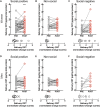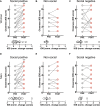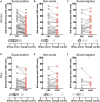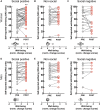Social Feedback During Sensorimotor Synchronization Changes Salivary Oxytocin and Behavioral States
- PMID: 33071856
- PMCID: PMC7538614
- DOI: 10.3389/fpsyg.2020.531046
Social Feedback During Sensorimotor Synchronization Changes Salivary Oxytocin and Behavioral States
Abstract
In humans and animal models, oxytocin increases social closeness, attachment and prosocial behaviors, while decreasing anxiety and stress levels. Efficiently triggering the release of endogenous oxytocin could serve as a powerful therapeutic intervention for disorders of social behavior and for anxiety. We designed a new version of a social sensorimotor synchronization task to investigate the role of social approval in inducing biochemical and psychological changes following behavioral synchrony in a sample of 80 college students. Social approval in the form of real time positive feedback increased well-being only in women, while increasing social closeness in both genders. Social disapproval in the form of real time negative feedback prevented a decrease in stress levels that otherwise women reported following engagement in either social or non-social synchronization. Surprisingly, for certain personality traits, negative social feedback during sensorimotor synchronization was psychologically beneficial irrespective of gender. Salivary oxytocin levels increased only in women after the social but not the non-social synchronization tasks. Oxytocin dynamics were independent of the type of real time feedback that subjects received, indicating the existence of distinct mechanisms for hormonal versus behavioral changes following synchronization. Nevertheless, changes in salivary oxytocin after positive social feedback correlated with changes in well-being and predicted changes in prosocial attitudes. Our findings show evidence of distinct mechanisms for behavioral versus hormonal changes following social sensorimotor synchronization, and indicate that gender and personality traits should be carefully considered when designing behavioral therapies for improving social attitudes and for stress management.
Keywords: closeness; gender; oxytocin (OXT); personality traits; social approval; social synchronization; well-being.
Copyright © 2020 Papasteri, Sofonea, Boldasu, Poalelungi, Tomescu, Pistol, Vasilescu, Nedelcea, Podina, Berceanu, Froemke and Carcea.
Figures






Similar articles
-
Reduced salivary oxytocin after an empathic induction task in Intimate Partner Violence perpetrators: Importance of socio-affective functions and its impact on prosocial behavior.Psychoneuroendocrinology. 2022 Mar;137:105644. doi: 10.1016/j.psyneuen.2021.105644. Epub 2021 Dec 23. Psychoneuroendocrinology. 2022. PMID: 34979319
-
Oxytocin selectively facilitates learning with social feedback and increases activity and functional connectivity in emotional memory and reward processing regions.Hum Brain Mapp. 2015 Jun;36(6):2132-46. doi: 10.1002/hbm.22760. Epub 2015 Feb 9. Hum Brain Mapp. 2015. PMID: 25664702 Free PMC article.
-
Chronic intranasal oxytocin reverses stress-induced social avoidance in female prairie voles.Neuropharmacology. 2021 Oct 15;198:108770. doi: 10.1016/j.neuropharm.2021.108770. Epub 2021 Aug 28. Neuropharmacology. 2021. PMID: 34461067
-
The role of oxytocin in social bonding, stress regulation and mental health: an update on the moderating effects of context and interindividual differences.Psychoneuroendocrinology. 2013 Sep;38(9):1883-94. doi: 10.1016/j.psyneuen.2013.06.019. Epub 2013 Jul 12. Psychoneuroendocrinology. 2013. PMID: 23856187 Review.
-
Oxytocin in General Anxiety and Social Fear: A Translational Approach.Biol Psychiatry. 2016 Feb 1;79(3):213-21. doi: 10.1016/j.biopsych.2015.06.004. Epub 2015 Jun 10. Biol Psychiatry. 2016. PMID: 26208744 Review.
Cited by
-
Endogenous Oxytocin Levels in Autism-A Meta-Analysis.Brain Sci. 2021 Nov 21;11(11):1545. doi: 10.3390/brainsci11111545. Brain Sci. 2021. PMID: 34827545 Free PMC article. Review.
-
Oxytocin predicts positive affect gains in a role-play interaction.Front Psychol. 2024 May 30;15:1258254. doi: 10.3389/fpsyg.2024.1258254. eCollection 2024. Front Psychol. 2024. PMID: 38873527 Free PMC article.
References
-
- Aron A., Aron E. N., Smollan D. (1992). Inclusion of other in the self scale and the structure of interpersonal closeness. J. Pers. Soc. Psychol. 63 596–612. 10.1037/0022-3514.63.4.596 - DOI
-
- Ashton-James C., Van Baaren R. B., Chartrand T. L., Decety J., Karremans J. (2007). Mimicry and me: the impact of mimicry on self–construal. Soc. Cogn. 25 518–535. 10.1521/soco.2007.25.4.518 - DOI
Grants and funding
LinkOut - more resources
Full Text Sources

